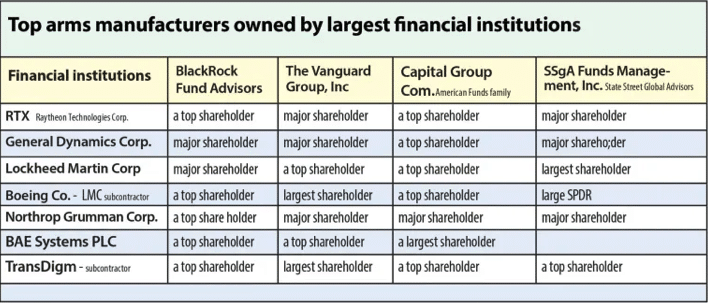Lenin wrote in “Imperialism, the Highest Stage of Capitalism”:
I trust that this pamphlet will help the reader to understand the economic essence of imperialism, for unless this is studied, it will be impossible to understand and appraise modern war and modern politics.
In the new book “Lenin and War in the 21st Century,” author Gary Wilson writes about industrial capital merging with banking capital, creating “finance capital,” a financial oligarchy. This combination allows financial institutions to exert significant control over the economy as well as the government.
The banking institutions of monopoly capitalism own the arms manufacturers that are supplying weapons of genocide in Gaza warfare. The competitive drive to expand profitable investments and to absorb an ever-greater proportion of the U.S. government’s budget is fueling the broader war fronts all across the globe. It is threatening to develop into a Third World War.

The shadow banking system
BlackRock (BLK) is the largest private asset manager, holding about $10 trillion in assets as of 2022. The company became the leading asset management operation after it acquired several large firms’ portfolios, including Merrill Lynch Investment Management and Barclay’s Global Investors (BGI).
According to data from WallStreetZen, as of April 2023, 61.87% of BLK shares were owned by institutional investors, investment firms, and asset managers. This means that over half of the Blackrock shareholders are investment firms and asset managers, similar to BlackRock.
As of April 2023, the institutions with the most BLK stock were The Vanguard Group, State Street Corp, and Bank of America (BofA). BofA is the second biggest bank in the U.S. after JP Morgan.
The Vanguard Group is a U.S.-based asset management firm that oversees more than $8 trillion in assets for both individual and institutional investors.
Capital Group Companies manages more than $2.3 trillion in investments. In 1953, an investment in Royal Dutch Petroleum made Capital Group one of the first U.S.-based finance capital firms to invest outside the U.S. After WWII, U.S. finance capital became dominant globally with the U.S. dollar becoming the world currency.
State Street Global Advisors, Inc. is the world’s fourth-largest asset manager, with nearly $4.14 trillion in assets in December 2021.
These institutions are known as the shadow banking system. Shadow banks are not regulated and include hedge funds, private equity funds, mortgage lenders, and some large investment banks.
Their lethal assets
RTX (formerly Raytheon) is the second largest U.S. defense contractor behind Lockheed Martin. RTX manufactures weapons and military electronics. It is the world’s largest producer of guided missiles and special-mission aircraft, including the Patriot system, a shoulder-fired stinger missile.
General Dynamics supplies technologically advanced wheeled combat vehicles, including the Abrams tank, Stryker combat vehicles, LAVs and AJAX armored fighting vehicles. They provide weapons systems, nuclear submarines, and munitions for naval, air, and ground forces across all weapons platforms, boasting that they “offer lethality on the battlefield.”
Lockheed Martin provides helicopters and rotary-wing military aircraft to all five branches of the U.S. armed forces, along with military services and commercial operators in 40 nations. Lockheed claims their aircraft can target static or moving targets with rockets and laser-designated air-to-ground missiles. Their long-range, guided missile carries a 500-pound class blast fragmentation warhead.
In a joint venture, Lockheed Martin and Northrop Grumman prepared a high-tech system they call a ”force multiplier” that is supposed to provide aircrews with automatic target detection while enabling rapid, multi-target engagement in all weather conditions over multiple types of terrain.
In 1993, Lockheed purchased the Fort Worth-based jet fighter division of the General Dynamics Corporation, giving them the F-16 fighter program and a greater stake in developing the F-22 “stealth” fighter. The $3.5 billion F-22, by the way, is not yet working. The U.S. Air Force says it can’t use the F-22 jets because it would require too much effort and cost too much to get the aircraft ready for battle.
Northrop Grumman pioneered stealth technology to keep military aircraft virtually unseen. They claim to lead in advanced multifunction systems that will deliver intelligence, surveillance and reconnaissance, electronic attack, and multi-domain networking capabilities for the U.S. defense and intelligence community and international customers.
They are the prime contractor delivering the $21 billion B-21 Raider, a so-called strategic bomber. The B-21, only one of which has been built, making a single test flight in November 2023, is designed to be a nuclear bomber.
In April 1994, the company was formed when Northrop Corporation acquired Grumman Corporation. Lockheed Martin then acquired Northrop Grumman in July 1997.
Boeing designs, manufactures, and sells military weapons, including attack helicopters, combat aircraft, missiles, bombs, battlefield laser systems, and intelligence and surveillance systems. Boeing’s AH-64 is a combat helicopter for the U.S. Army and many other countries’ military forces.
The Ground-based Midcourse Defense (GMD) system is the United States missile defense program. As prime contractor, Boeing designs, produces, integrates, tests and sustains all GMD components deployed across 15 time zones.
TransDigm, as a subcontractor, buys up companies the military depends on for spare parts. By providing maintenance and parts for weapons it creates a locked-in market.
Forbes magazine reported in May 2023 that the expansion of NATO has opened up a big new market for U.S. military-industrial complex defense contractors. It’s “a big win” for Raytheon, Lockheed Martin, and Northrop Grumman.
More importantly, aligning with NATO is a commitment to interoperability with the American defense ecosystem. This directly benefits the big U.S. contractors. The market for their goods is expanding and they will face no competition for the foreseeable future…
The F-35-ification of European armies might be a bigger deal, though. In addition to the cost of the units, corresponding ground support, spare parts and maintenance, there is a lock-in factor. Europe is now committed to America-made gear for decades to come.
Weaponry acquired by the Defense Department is a process that is most easily navigated by experienced defense contractors like Lockheed Martin, Boeing, and General Dynamics.
The 10 most expensive weapons systems in the world total $868 billion in research and development and manufacturing costs. The Department of Defense has commissioned each of the 10 weapons systems.
Weapons contractors set their own inflated prices
Military contractors overcharge the Pentagon on almost everything the Department of Defense buys each year, expertShay Assad told 60 Minutes on May 21, 2023. Assad is now retired after four decades negotiating weapons deals for Raytheon and then for the U.S. Defense Department.
Assad points to the Patriot weapons system purchased by the U.S., NATO, Ukraine, and Taiwan. In 2015, Assad ordered a review, and Army negotiators discovered Lockheed Martin and its subcontractor, Boeing, were grossly overcharging the Pentagon and U.S. allies by hundreds of millions of dollars for the Patriot’s PAC-3 missiles.
Shay Assad said,
The average profitability that was negotiated in a firm fixed price contract was typically between 12% and 15%. But Pentagon analysts found total profits approached 40%.
In 1993, the Pentagon, claiming that it was aiming to cut costs, urged defense companies to merge. Fifty-one major contractors consolidated into five giants. In the early 2000s, the Pentagon, in another cost-saving move, cut 130,000 employees whose jobs were to negotiate and oversee defense contracts.
Assad said.
They were convinced that they could rely on the companies to do what was in the best interests of the war fighters and the taxpayers.
Now that Raytheon is the sole supplier of stinger missiles, the cost is seven-fold more than in 1991.
The cost of Lockheed Martin’s troubled F-35 program, seven years behind schedule—is now $90 billion over the original estimate and may end up costing taxpayers $1.3 trillion. The Pentagon had ceded control of the program to Lockheed Martin. Lockheed and its suppliers retained control of design and repair data—the proprietary information needed to fix and upgrade the plane. The weapon system belongs to the defense department. However, the data underlying the design of the airplane does not.
When a part breaks, it’s likely to come from a subcontractor like TransDigm, which has seen its stock soar as it buys up companies the military depends on for spare parts. Assad’s review team found the government “will pay” the company “$119 million” for parts that “should cost $28 million.”
Since 2002, total arms sales among the 100 largest arms manufacturers have increased by 60%. Over half of all arms sales that year were made by 10 companies with the highest revenue from arms sales.

